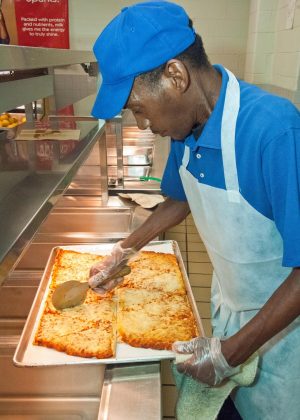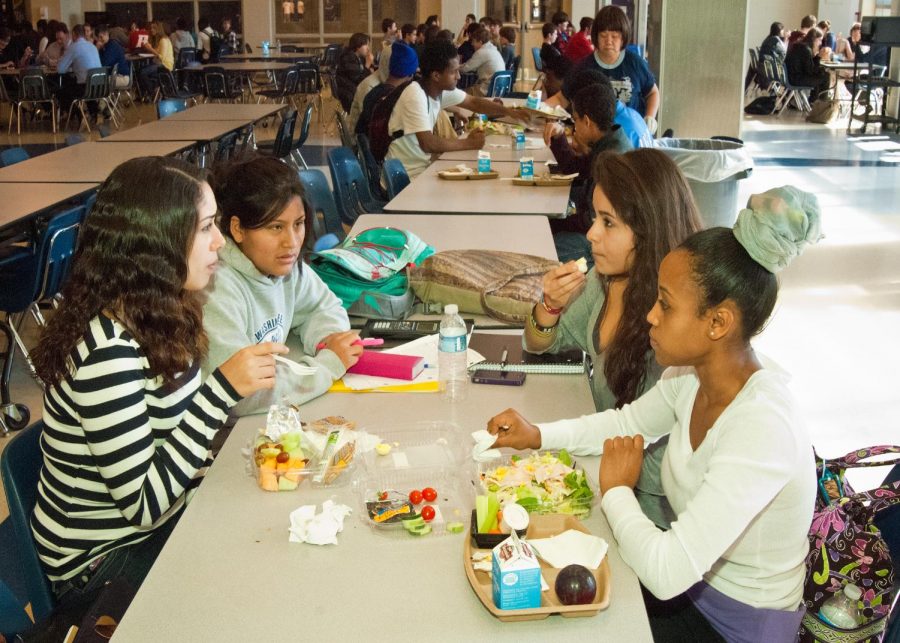School lunch nutrition remains a difficult challenge
Photo courtesy of Bob Nichols under Creative Commons license
Students may opt for the limited healthier menu options offered by MCPS, such as salads.
June 12, 2019
Prom, spirit weeks and all-nighters are all staples of the high school experience, but there is one significantly less exciting aspect of school life to which many students are privy: school lunches. School lunch horror-stories have come to be an expectation rather than a surprise, with endless tales of woe about moldy mac-and-cheese, and inadequate servings. But are these narratives true to life, or are they simply the exaggerated products of sleep-deprived students?
Although grimy cafeterias and sloppy joe dollops (emphasis on sloppy) are featured heavily in popular coming-of-age movies and teen shows, MCPS administration and Richard Montgomery staff have worked hard to make school lunches nutritious and to keep the cafeteria clean for the health of the students, with the menu planned by a committee of licensed dieticians.
According to the School Nutrition Association, school meals must follow federal nutrition standards in order to receive federal reimbursement. However, federal regulations are always changing, particularly under the Trump administration.
A rule published by the United States Department of Agriculture on Dec. 12, 2018 stated that only half of the weekly grains in the school lunch and breakfast menus must be whole grain-rich—at least 50 percent whole grain—as opposed to all, as was the rule under the Obama administration since the 2014-2015 school year. In addition, the rule allowed schools to permanently offer flavored, low-fat milk, such as 1 percent chocolate milk, rather than just fat-free. It also pushed back the deadline for sodium reduction to the end of the 2023-2024 school year. This rule is effective July 1, 2019.
These changes have loosened the guidelines on nutrition requirements for school lunch, but they do not force schools to alter their lunch menus at all if they were in regulation with the original requirements. In fact, the rule explicitly states that the USDA “affirms its commitment to give schools more control over food service decisions and greater ability to offer wholesome and appealing meals that reflect local preferences.”
Richard Montgomery and all other MCPS schools will not undergo any menu changes as a result of this new rule, as they already meet the stricter Obama administration guidelines. “We do not plan to relax or change our items at all,” MCPS Division of Food and Nutrition Services Director Susan McCarron said. Meaning, no decrease in whole grains, no addition of flavored low-fat milk and no increase in sodium.

A cafeteria worker slices pizza, one of the daily MCPS menu options, in preparation for the incoming lunch rush.
But these couple of regulations do not make a healthy meal in and of themselves. Although the school lunch menus meet USDA guidelines, there is no system in place to ensure that students will choose a full, healthy meal for themselves. “If I go in and I only get a hamburger every day, or a piece of pizza that’s a la carte and, say, a banana. That is not a healthy diet and that is not varied and it won’t meet all my needs,” MCPS DFNS Assistant Director Barbara Harral said. “The menu planned would be that you might get a hamburger today, but that you also get lettuce and tomato to put on that hamburger, that you would get a fresh orange or apple slices and milk to go with that.”
This example of an unhealthy meal seems to reflect the typical view of a school lunch. “I wouldn’t want my kids to eat there every day because I’m sure it’s high in fat and salt content,” physics teacher Jon Goetz said. “It’s probably not the best nutrition—buy a lunch maybe supplemented with fruit or things like that.”
Many students recognize the range of choices in the cafeteria. “I think that the cafeteria definitely works to provide options so that students could theoretically get enough nutrition, but students don’t always choose a balanced meal,” senior Ivy Han said.
In addition, unhealthy meals have other, seemingly unrelated repercussions. According to USDA regulation, student meals without at least half a cup of fruits or vegetables, on top of being unhealthy, also are not reimbursable, meaning the school will not receive monetary compensation from the federal government for that meal. This hinders the school’s ability to continue to provide adequate funding for the Free and Reduced Meals (FARMs) program.
However, oftentimes students do not choose to be unhealthy; they simply do not have any other option. The very examples provided by Harral are not an option in the RM school cafeteria. “You usually see hamburgers or chicken or pizza mostly. The more healthy stuff like apples are really few and are not good quality. They’re not fresh,” junior Reja Wasty said. The apple slices in the cafeteria are always packaged, and so their freshness seems questionable at best. Students also do not have the option to put tomatoes or lettuce on their sandwiches.
Financial barriers can also prevent students from choosing healthier options. “I usually take the fruits if they are free,” junior Andrea Crez said. “Add more veggies, like salads. Usually, salads are not free. Usually, the free food are foods like pizzas or hamburgers.”
As for the cleanliness of school lunches and cafeterias, RM must meet strict inspection guidelines in order to comply with Maryland’s standards for student health. According to the Health and Human Services Division of Montgomery County Government, the Licensure and Regulatory Services Program regularly inspects cafeterias to evaluate the sanitation, maintenance and food services operations for the facility. These inspections are split into two parts: a comprehensive inspection and a monitoring inspection, which checks equipment and general cleanliness practices.
In an effort to remain transparent with students and visitors, MCPS requires schools to display inspection results in the cafeteria or kitchen where it is visible to the public. In addition, according to the MCPS Wellness and Nutrition Department, “Cafeteria managers are certified in food safety and all employees receive food safety training both on the job and at regular in-service meetings.”
Building Services Manager Jacqueline Rosario began working at RM in late September of last year. Rosario assures that all cafeterias are thoroughly cleaned every day for an hour after breakfast and an hour and a half after lunch. Inspections come twice a year, and are always extremely thorough. “They inspect blinds… the trash cans… the floor, the tables and also the ceiling to see if every ceiling tile is in place,” Rosario said. “Also they check lights to see if all the lights are working, including emergency lights. They check the kitchen to see if all the kitchen equipment is in working condition with Maryland compliance.”
Richard Montgomery students generally agree that the cafeteria itself is adequately clean, and administration claims that the food is healthy and nutritious for the students. The problem comes with the disparity between what the students expect and what is delivered.



